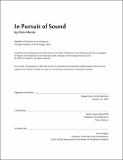| dc.contributor.advisor | Antón García-Abril. | en_US |
| dc.contributor.author | Martin, Chris (Christopher Landrum) | en_US |
| dc.contributor.other | Massachusetts Institute of Technology. Department of Architecture. | en_US |
| dc.date.accessioned | 2015-06-10T18:41:38Z | |
| dc.date.available | 2015-06-10T18:41:38Z | |
| dc.date.copyright | 2015 | en_US |
| dc.date.issued | 2015 | en_US |
| dc.identifier.uri | http://hdl.handle.net/1721.1/97269 | |
| dc.description | Thesis: M. Arch., Massachusetts Institute of Technology, Department of Architecture, 2015. | en_US |
| dc.description | This electronic version was submitted by the student author. The certified thesis is available in the Institute Archives and Special Collections. | en_US |
| dc.description | CD-ROM contains audio of thesis presentation, mp4 format. | en_US |
| dc.description | Cataloged from student-submitted PDF version of thesis. | en_US |
| dc.description | Includes bibliographical references (page 71). | en_US |
| dc.description.abstract | Architectural tools are built around visualizing our environment, however it is sound that paints the most accurate picture of our experiences. A glass wall feels more constricting than a opaque sheet, because when sound can reach our ears, our worlds are opened up. It is time that we leverage the technology that gives us so much insight into the science of sound, and start designing architectural experiences that can communicate visually what we understand sonically. Historically we have relied on a known quantity of sound in order to generate space. Pythagoras unifies specific rules of harmony and proportion from sound in order to determine guidelines for pleasant spaces. Years later, Xenakis composes a musical score that informs the constructed surface of the Philips pavilion. Both pioneers of sonic architecture, and both pushing the technology of sound design. This thesis advances the theory of sound architecture by focusing on the smallest component of sound -the frequency- and translating that into the smallest component of form, -the gradient. Frequencies layer on one another to create an entire sonic composition, so must the gradients blend together to bring architecture into being. The invitation to explore sonic movements as architectural experiences comes from the success of these gradients to convey imagined spaces among a flat image. It is through the production and implementation of this image that the architect can seek new control over visual forms that capture the ears as well as the eyes. | en_US |
| dc.description.statementofresponsibility | by Chris Martin. | en_US |
| dc.format.extent | 71, 2 unnumbered pages | en_US |
| dc.language.iso | eng | en_US |
| dc.publisher | Massachusetts Institute of Technology | en_US |
| dc.relation.requires | System requirements: Windows and CD-ROM drive. | en_US |
| dc.rights | M.I.T. theses are protected by copyright. They may be viewed from this source for any purpose, but reproduction or distribution in any format is prohibited without written permission. See provided URL for inquiries about permission. | en_US |
| dc.rights.uri | http://dspace.mit.edu/handle/1721.1/7582 | en_US |
| dc.subject | Architecture. | en_US |
| dc.title | In pursuit of sound | en_US |
| dc.type | Thesis | en_US |
| dc.description.degree | M. Arch. | en_US |
| dc.contributor.department | Massachusetts Institute of Technology. Department of Architecture | |
| dc.identifier.oclc | 910669650 | en_US |
